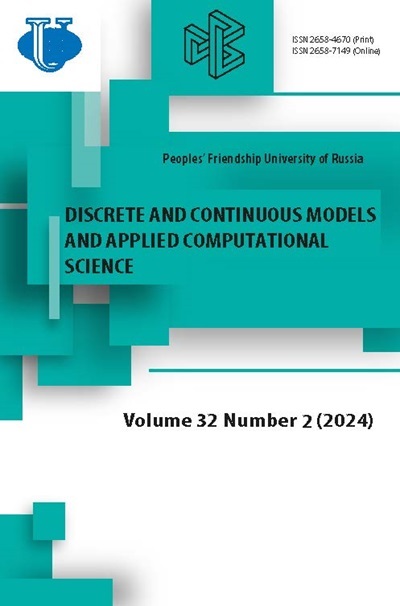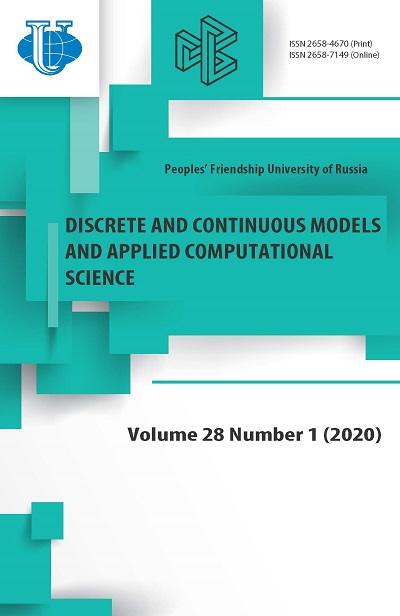Верификация рынка труда с помощью академической краудсорсинговой системы
- Авторы: Азофейфа Э.J.1, Новикова Г.М.1
-
Учреждения:
- Российский университет дружбы народов
- Выпуск: Том 28, № 1 (2020)
- Страницы: 5-16
- Раздел: Информатика и вычислительная техника
- URL: https://journals.rudn.ru/miph/article/view/23693
- DOI: https://doi.org/10.22363/2658-4670-2020-28-1-5-16
Цитировать
Полный текст
Аннотация
В настоящее время студенты, желающие иметь преимущество на рынке труда, готовы платить значительные деньги за информацию о потенциальных возможностях трудоустройства, тогда как получение диплома волнует их все в меньшей степени. Рассматривая поведение этого рынка труда в качестве теории предметной области в условиях неопределённости, ожидаются некоторые противоречия в виде уровней заработной платы, которые невозможно классифицировать из-за высокой противоречивости и изменчивости. Нами представлен алгоритм верификации теории предметной области рынка труда на основе краудсорсинговой академической системы, в которой обратная связь о возможных противоречиях формируется в результате консультаций с экспертами на рынке и группируется в различных контекстах. Нами обнаружено, что процесс проверки может повторяться итеративно, если общая стоимость обучения студентов равна или превышает количество, частично определяемое числом различных профилей студентов.
Ключевые слова
Об авторах
Эстебан Азофейфа
Российский университет дружбы народов
Автор, ответственный за переписку.
Email: azofeyfa-gomez-e@rudn.ru
аспирант кафедры информационных технологий
ул. Миклухо-Маклая, д. 6, Москва, 117198, РоссияГалина Михайловна Новикова
Российский университет дружбы народов
Email: novikova-gm@rudn.ru
кандидат технических наук, доцент кафедры информационных технологий
ул. Миклухо-Маклая, д. 6, Москва, 117198, РоссияСписок литературы
- M. G. Staton, “Improving Student Job Placement and Assessment Through the Use of Digital Marketing Certification Programs,” Marketing Education Review, vol. 26, pp. 20-24, 2016. doi: 10.1080/10528008. 2015.1091665.
- M. Scholten and N. Tieben, “Vocational qualification as safety-net? Education-to-work transitions of higher education dropouts in Germany,” Empirical Research in Vocational Education and Training, vol. 9, 2017. doi: 10.1186/s40461-017-0050-7.
- I. Fedorenko and P. Berthon, “Beyond the expected benefits: unpacking value co-creation in crowdsourcing business models,” AMS Review, vol. 7, pp. 183-194, 2017. doi: 10.1007/s13162-017-0106-7.
- J. Jiang, B. An, Y. Jiang, D. Lin, Z. Bu, J. Cao, and Z. Hao, “Understanding Crowdsourcing Systems from a Multiagent Perspective and Approach,” ACM Transactions on Autonomous and Adaptive Systems, vol. 13, 2018. doi: 10.1145/3226028.
- D. E. Difallah, M. Catasta, G. Demartini, P. G. Ipeirotis, and P. CudrMauroux, “The dynamics of micro-task crowdsourcing,” Proceedings of the 24th International Conference on World Wide Web - WWW’15, pp. 238-247, 2015. doi: 10.1145/2736277.2741685.
- E. J. Azofeifa and G. M. Novikova, “VUZ: a crowdsourced framework for scalable interdisciplinary curriculum design,” 2018 IV International Conference on Information Technologies in Engineering Education (Inforino), pp. 188-193, 2018. doi: 10.1109/inforino.2018.8581804.
- R. Baker, E. Bettinger, B. Jacob, and I. Marinescu, “The Effect of Labor Market Information on Community College Students’ Major Choice,” Economics of Education Review, vol. 65, pp. 18-30, 2018. doi: 10.1016/j.econedurev.2018.05.005.
- N. Engbom, “Firm and Worker Dynamics in an Aging Labor Market,” Federal Reserve Bank of Minneapolis, Working Papers 756, Apr. 2019. doi: 10.21034/wp.756.
- P. Pollok, D. Lüttgens, and F. T. Piller, “How Firms Develop Capabilities for Crowdsourcing to Increase Open Innovation Performance: The Interplay between Organizational Roles and Knowledge Processes,” Journal of Product Innovation Management, vol. 36, pp. 412-441, 2019. doi: 10.1111/jpim.12485.
- A. Sutcliffe, The Domain Theory: Patterns for Knowledge and Software Reuse. Mahwah NJ: Lawrence Erlbaum Associates, 2002. DOI: 10.1201/ b12455.
- H. S. Sugiarto, E. Lim, and N. L. Sim, “On analysing supply and demand in labor markets: Framework, model and system,” in Proceedings of the 6th IEEE International Conference on Data Science and Advanced Analytics, Research Collection School of Information Systems, 2019. doi: 10.1109/DSAA.2019.00066.
- A. Artikis, M. Sergot, J. Pitt, D. Busquets, and R. Riveret, “Specifying and Executing Open Multi-agent Systems,” in Social Coordination Frameworks for Social Technical Systems. Law, Governance and Technology Series. Cham: Springer, 2016, vol. 30. doi: 10.1007/978-3-31933570-4_10.
- T. Wiedemann, C. Manss, and D. Shutin, “Multi-agent exploration of spatial dynamical processes under sparsity constraints,” Autonomous Agents and Multi-Agent Systems, vol. 32, pp. 134-162, 2018. DOI: 10. 1007/s10458-017-9375-7.
- C. Fieseler, E. Bucher, and C. P. Hoffmann, “Unfairness by Design? The Perceived Fairness of Digital Labor on Crowdworking Platforms,” Journal of Business Ethics, vol. 156, pp. 987-1005, 2019. DOI: 10.1007/ s10551-017-3607-2.
- R. Casidy and W. Wymer, “A taxonomy of prestige-seeking university students: strategic insights for higher education,” Journal of Strategic Marketing, vol. 26, pp. 140-155, 2018. doi: 10.1080/0965254X.2016. 1182573.
- H. Buchs, E. Murphy, and M. Buchmann, “Landing a job, sinking a career? The trade-off between occupational downgrading and quick reemployment according to unemployed jobseekers’ career stage and job prospects,” Research in Social Stratification and Mobility, vol. 52, pp. 26-35, 2017. doi: 10.1016/j.rssm.2017.10.001.
- R. M. Smullyan, Theory of Formal Systems: Annals of Mathematics Studies. Princeton University Press, 1961.
- P. Cousot, “Verification by Abstract Interpretation,” in Verification: Theory and Practice. Lecture Notes in Computer Science. Berlin, Heidelberg: Springer, 2003, vol. 2772. doi: 10.1007/978-3-540-39910-0_11.
- G. M. Novikova, E. J. Azofeifa, and V. R. Milov, “Towards the formalization of contradictions in a legal multiagent system,” Procedia Computer Science, vol. 150, pp. 488-494, 2019. doi: 10.1016/j.procs.2019.02. 083.
- J. Eklundh and M. Björkman, “Recognition of Objects in the Real World from a Systems Perspective,” Kuenstliche Intelligenz, vol. 19, pp. 12-17, 2005.
- S. Shapiro, “Incompleteness and Inconsistency,” Mind, vol. 111, pp. 817- 832, 2002. doi: 10.1093/mind/111.444.817.
- P. Cousot, “Conflicts of Ontologies - Classification and Consensus-Based Methods for Resolving,” in Knowledge-Based Intelligent Information and Engineering Systems. KES 2006. Lecture Notes in Computer Science. Berlin, Heidelberg: Springer, 2006, vol. 4252. doi: 10.1007/11893004_ 34.
- D. H. Wexler, “Integrating computer technology: Blurring the roles of teachers, students, and experts,” in Computing and Educational Studies: A Special Issue of Educational Studies. Routledge, 2000, vol. 31, pp. 33- 43.
- C. M. Chen, C. Y. Liu, and M. H. Chang, “Personalized curriculum sequencing utilizing modified item response theory for web-based instruction,” Expert Systems with Applications, vol. 30, pp. 378-396, 2006. doi: 10.1016/j.eswa.2005.07.029.
- M. De Paola, V. Scoppa, and R. Nisticó, “Monetary Incentives and Student Achievement in a Depressed Labor Market: Results from a Randomized Experiment,” Journal of Human Capital, vol. 6, pp. 56-85, 2012. doi: 10.1086/664795.
- T. Collins, R. Hawkins, and E. M. Flowers, “Peer-Mediated Interventions: a Practical Guide to Utilizing Students as Change Agents,” Contemp School Psychol, vol. 22, pp. 213-219, 2018. doi: 10.1007/s40688-017- 0120-7.
- R. Suzuki, N. Salehi, M. S. Lam, J. C. Marroquin, and M. S. Bernstein, “Atelier: Repurposing Expert Crowdsourcing Tasks as MicroInternships,” in Proceedings of the 2016 CHI Conference on Human Factors in Computing Systems, New York, NY, USA: Association for Computing Machinery, 2016, pp. 2645-2656. doi: 10.1145/2858036. 2858121.
- A. Felce, S. Perks, and D. Roberts, “Work-based skills development: a context-engaged approach,” Higher Education, Skills and Work-Based Learning, vol. 6, pp. 261-276, 2016. doi: 10.1108/HESWBL-12-2015- 0058.
- J. Beck, K. Ostrow, and Y. Wang, “Students vs. skills: Partitioning variance explained in learner models,” in Student modeling from different aspects. Worcester Polytechnic Institute, 2016, pp. 2-9.
- G. M. Novikova, “Evaluation of the competence of personnel in the corporate management system [Otsenka kompetentnosti personala v korporativnoy sisteme upravleniya],” Competencies and expertise of the modern specialist [Kompetentsii i kompetentnost’ sovremennogo spetsialista], pp. 78-95, 2011, in Russian.
- Q. Zou, S. Xie, Z. Lin, M. Wu, and Y. Ju, “Finding the Best Classification Threshold in Imbalanced Classification,” Big Data Research, vol. 5, pp. 2- 8, 2016. doi: 10.1016/j.bdr.2015.12.001.
- S. Russell and P. Norvig, Artificial intelligence. Harlow: Pearson Education UK, 2016.
- L. A. Gottlieb, A. Kontorovich, and P. Nisnevitch, “Nearly Optimal Classification for Semimetrics,” Journal of Machine Learning Research, vol. 18, pp. 1233-1254, 2017. doi: 10.5555/3122009.3122046.
















